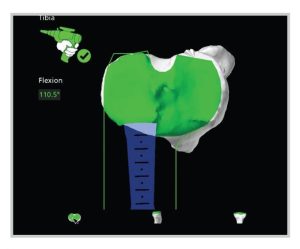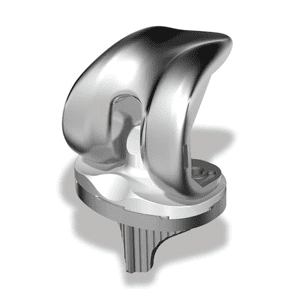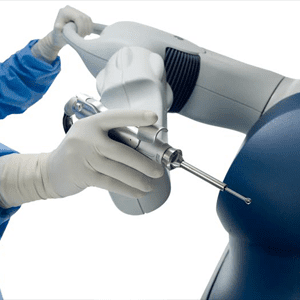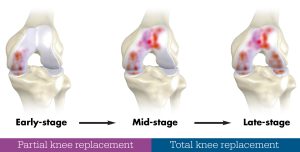Mako SmartRobotics™ at St. Joseph Hospital
Studies show that knee replacements in the United States are expected to increase 189% by the year 2030. As a part of our ongoing efforts to best serve the Greater Nashua community, St. Joseph Hospital Orthopedics is proud to offer Stryker’s Mako Robotic-Arm assisted surgery, which transforms the way that total and partial knee replacements are performed.
Mako SmartRobotics™ is equipped with Accustop™ haptic technology, which enables surgeons to limit soft tissue damage by providing visual, auditory, and tactile feedback, limiting sawblade action outside of the haptic boundary.
Get Moving Again
We understand that knowing what to expect from your joint replacement experience is important to you. That’s why St. Joseph Hospital Orthopedics in Nashua, New Hampshire, works closely with New Hampshire Orthopaedic Center to best serve our patients. Dr. Albert Tom, Dr. Kathleen A. Hogan, and Dr. Andrew T. Garber, have all gone through an extensive amount of training on using the Mako SmartRobotics™ system and are some of the only specialists in the Southern New Hampshire region who have this certification.
How Mako SmartRobotics™ Works
St. Joseph Hospital Orthopedics in Nashua, New Hampshire, sought after Mako SmartRobotics™ as an innovative solution for many patients suffering from painful arthritis of the knee. Mako uses 3D CT-based planning software so our surgeons can know more about your anatomy to create a personalized joint replacement surgical plan. This 3D model is used to preplan and assist us, as your surgeons, in performing your total or partial knee replacement.
 Pictured left is a 3D CT scan.
Pictured left is a 3D CT scan.
What to Expect
For both total and partial knee replacements, our highly trained surgeons at St. Joseph Hospital Orthopedics in Nashua, New Hampshire, follow your personalized surgical plan while preparing for the bone for the triathlon knee replacement. With over a decade of clinical history, this technique is much different than traditional knee replacements because they are designed to work with the body to promote natural-like circular motion.
 Pictured left is a triathlon knee replacement.
Pictured left is a triathlon knee replacement.
Our surgeons guide Mako’s robotic arm within the predefined area, and Mako’s Accustop™ technology helps our surgeons stay within the planned boundaries that were defined when the personalized pre-operative plan was created. By guiding our surgeons during surgery, Mako’s AccuStop™ technology allows for our surgeons to cut less by cutting precisely what’s planned to help protect your healthy bone and preserve tissue.
 Pictured left is how our surgeon guides the Mako arm.
Pictured left is how our surgeon guides the Mako arm.
Surgical Information
It’s important to understand that the surgery is performed by one of St. Joseph Hospital’s Orthopedic surgeons, who guides the Mako’s robotic arm during the surgery to position the implant into the knee joint. Mako SmartRobotics™ does not perform the surgery, make decisions on its own, or move without the surgeon guiding it. Mako SmartRobotics™ also allows for our surgeon to make adjustments to your plan during surgery if needed.
Total Knee vs. Partial Knee
Based on the severity of the arthritis of the knee, total or partial knee replacements may be recommended by one of our board-certified surgeons from St. Joseph Hospital Orthopedics in Nashua, New Hampshire. Both procedures involve one of our surgeons guiding Mako’s robotic arm to remove diseased bone and cartilage.
A total knee replacement is a treatment option for adults living with mid to late stage Osteoarthritis (OA) of the knee. With a Mako total knee replacement, the entire knee joint is replaced, and the surgeon inserts a triathlon knee replacement. With over a decade of clinical history, triathlon knee replacements are much different than traditional knee replacements because they are designed to work with the body to promote natural-like circular motion.

A partial knee replacement is a treatment option for adults living with early to midstage Osteoarthritis (OA) that has not yet progressed to all three components of the knee. Depending on where the arthritis affects the knee, patients may have an implant in any of the following areas:
- In a unicondylar knee replacement, only one area (or compartment) of the knee joint is replaced.
- A patellofemoral knee replacement replaces the kneecap (or patella) and the grove at the lower end of the thighbone (or femur).
- A bicompartmental knee replacement affects two compartments of the knee – the inside (medial) and knee cap.
Watch How It Works
Additional Information
Each patient is unique and can experience joint pain for different reasons. It’s important to talk to us about the reasons behind your knee pain so you can understand the wide variety of treatment options available to you. Pain from arthritis and joint degeneration can be constant or come and go, occur with movement or after a period of rest, or be in one spot or many parts of the body.
It is common for patients to try medication and other conservative treatments to treat their knee pain. If you haven’t experienced adequate relief with those treatment options, you may be a candidate for a Mako total or partial knee replacement, which may provide you with relief from your knee pain.
Mako is the first and only robotic technology that can be used across the joint replacement service line to perform both total knee and partial knee replacements – and it’s right here at St. Joseph Hospital Orthopedics in Nashua, New Hampshire. Since 2007, more than 300,000 procedures for both total knee and partial knee replacements, have been performed with the Mako SmartRobotics™ system. Arm assisted surgery enables our surgeons to have a more predictable surgical experience and offers them a leadership advantage in our evolving healthcare environment.
"My initial knee injury was during high school football. It wasn't repaired properly. Since then, I had so much trouble walking. I was in so much pain and had horrible arthritis in both of my knees. Thankfully, I was able to have one of them repaired by Dr. Kathleen Hogan in the winter of 2022. I'm looking forward to having my second knee done. I'm so excited to go back to work afterwards."
Dave
Meet Our Team
St. Joseph Hospital Orthopedics in Nashua, New Hampshire, is looking forward to caring for you – with their top priority being to get moving freely and living a pain free life.